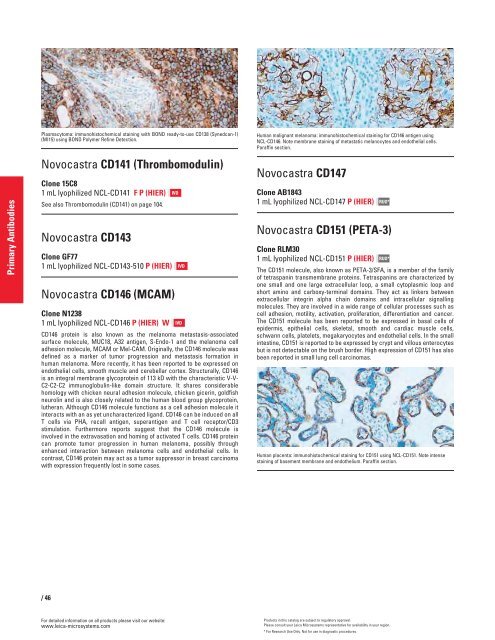QF0159 Marketing Release Record
QF0159 Marketing Release Record
QF0159 Marketing Release Record
You also want an ePaper? Increase the reach of your titles
YUMPU automatically turns print PDFs into web optimized ePapers that Google loves.
Primary Antibodies<br />
Plasmacytoma: immunohistochemical staining with BOND ready-to-use CD138 (Synedcan-1)<br />
(MI15) using BOND Polymer Refine Detection.<br />
Novocastra CD141 (Thrombomodulin)<br />
Clone 15C8<br />
1 mL lyophilized NCL-CD141 F P (HIER)<br />
See also Thrombomodulin (CD141) on page 104.<br />
Novocastra CD143<br />
Clone GF77<br />
1 mL lyophilized NCL-CD143-510 P (HIER)<br />
Novocastra CD146 (MCAM)<br />
Clone N1238<br />
1 mL lyophilized NCL-CD146 P (HIER) W<br />
CD146 protein is also known as the melanoma metastasis-associated<br />
surface molecule, MUC18, A32 antigen, S-Endo-1 and the melanoma cell<br />
adhesion molecule, MCAM or Mel-CAM. Originally, the CD146 molecule was<br />
defined as a marker of tumor progression and metastasis formation in<br />
human melanoma. More recently, it has been reported to be expressed on<br />
endothelial cells, smooth muscle and cerebellar cortex. Structurally, CD146<br />
is an integral membrane glycoprotein of 113 kD with the characteristic V-V-<br />
C2-C2-C2 immunoglobulin-like domain structure. It shares considerable<br />
homology with chicken neural adhesion molecule, chicken gicerin, goldfish<br />
neurolin and is also closely related to the human blood group glycoprotein,<br />
lutheran. Although CD146 molecule functions as a cell adhesion molecule it<br />
interacts with an as yet uncharacterized ligand. CD146 can be induced on all<br />
T cells via PHA, recall antigen, superantigen and T cell receptor/CD3<br />
stimulation. Furthermore reports suggest that the CD146 molecule is<br />
involved in the extravasation and homing of activated T cells. CD146 protein<br />
can promote tumor progression in human melanoma, possibly through<br />
enhanced interaction between melanoma cells and endothelial cells. In<br />
contrast, CD146 protein may act as a tumor suppressor in breast carcinoma<br />
with expression frequently lost in some cases.<br />
/46<br />
For detailed information on all products please visit our website:<br />
www.leica-microsystems.com<br />
IVD<br />
IVD<br />
IVD<br />
Human malignant melanoma: immunohistochemical staining for CD146 antigen using<br />
NCL-CD146. Note membrane staining of metastatic melanocytes and endothelial cells.<br />
Paraffin section.<br />
Novocastra CD147<br />
Clone AB1843<br />
1 mL lyophilized NCL-CD147 P (HIER)<br />
Novocastra CD151 (PETA-3)<br />
Clone RLM30<br />
1 mL lyophilized NCL-CD151 P (HIER)<br />
RUO*<br />
RUO*<br />
The CD151 molecule, also known as PETA-3/SFA, is a member of the family<br />
of tetraspanin transmembrane proteins. Tetraspanins are characterized by<br />
one small and one large extracellular loop, a small cytoplasmic loop and<br />
short amino and carboxy-terminal domains. They act as linkers between<br />
extracellular integrin alpha chain domains and intracellular signalling<br />
molecules. They are involved in a wide range of cellular processes such as<br />
cell adhesion, motility, activation, proliferation, differentiation and cancer.<br />
The CD151 molecule has been reported to be expressed in basal cells of<br />
epidermis, epithelial cells, skeletal, smooth and cardiac muscle cells,<br />
schwann cells, platelets, megakaryocytes and endothelial cells. In the small<br />
intestine, CD151 is reported to be expressed by crypt and villous enterocytes<br />
but is not detectable on the brush border. High expression of CD151 has also<br />
been reported in small lung cell carcinomas.<br />
Human placenta: immunohistochemical staining for CD151 using NCL-CD151. Note intense<br />
staining of basement membrane and endothelium. Paraffin section.<br />
Products in this catalog are subject to regulatory approval.<br />
Please consult your Leica Microsystems representative for availability in your region.<br />
* For Research Use Only. Not for use in diagnostic procedures.
















